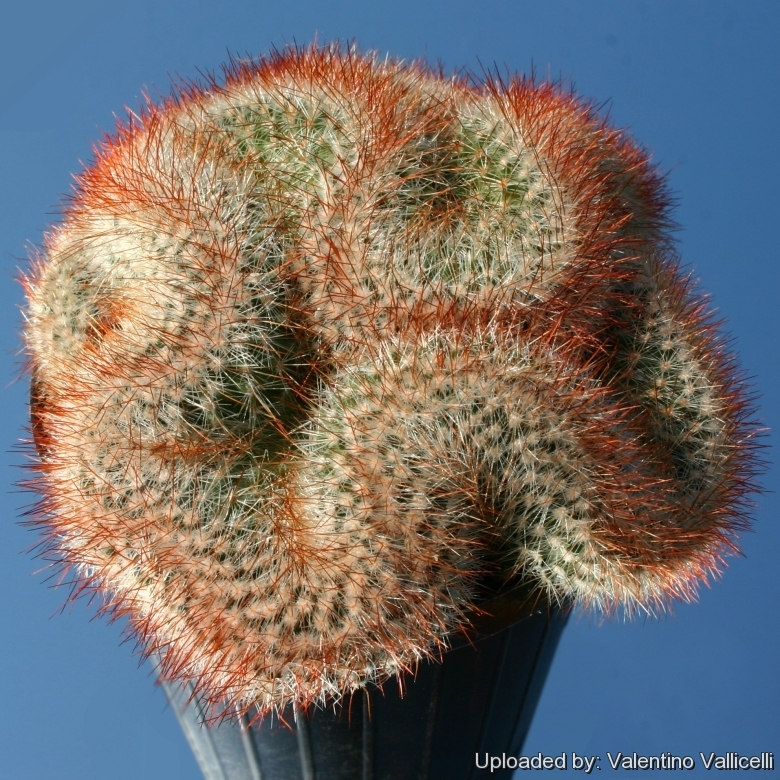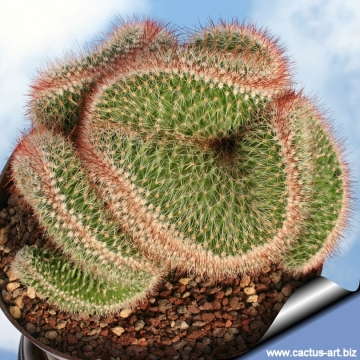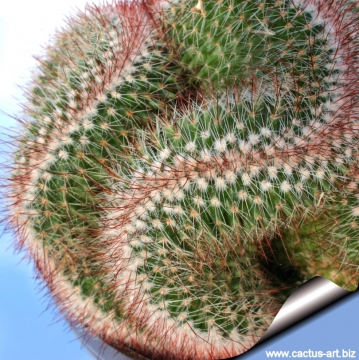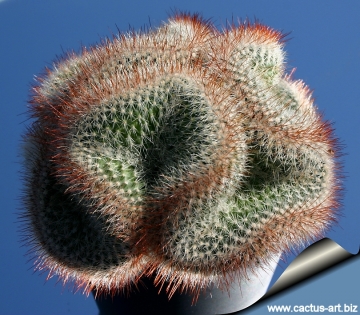




Your support is critical to our success.
Accepted Scientific Name: Mammillaria spinosissima Lem.
Cact. Aliq. Nov. Desc. 4. 1838 Lem.

Origin and Habitat: Garden origin (Nursery produced selection)
Synonyms:
Mammillaria spinosissima Lem.
Cact. Aliq. Nov. Desc. 4. 1838
Synonymy: 70
- Mammillaria spinosissima Lem.
- Cactus spinosissimus (Lem.) Kuntze
- Neomammillaria spinosissima (Lem.) Britton & Rose
- Mammillaria centraliplumosa Fittkau
- Mammillaria centraliplumosa var. gracilis Repp.
- Mammillaria gasterantha Repp.
- Mammillaria haasii J.Meyran
- Mammillaria hermannii var. flavicans Salm-Dyck
- Mammillaria pitcayensis Bravo
- Mammillaria pretiosa var. cristata Hildm. ex C.F.Först.
- Mammillaria spinosissima var. auricoma f. cristata hort.
- Mammillaria spinosissima var. aurorea (Ehrenb.) Gürke
- Cactus auroreus Kuntze
- Mammillaria aurorea Ehrenb.
- Mammillaria spinosissima brunnea Salm-Dyck
- Mammillaria spinosissima f. brunnea (Salm-Dyck) Gürke
- Mammillaria spinosissima var. castaneoides (Lem.) Borg in Borg
- Mammillaria spinosissima f. cristata
- Mammillaria spinosissima var. eximia (Ehrenb.) Gürke
- Cactus eximius (Ehrenb.) Kuntze
- Mammillaria eximia Ehrenb.
- Mammillaria spinosissima f. eximia (Ehrenb.) Schelle
- Mammillaria spinosissima var. flavida Salm-Dyck
- Mammillaria spinosissima f. flavida (Salm-Dyck) Gürke
- Mammillaria spinosissima var. genuina Gürke
- Mammillaria spinosissima var. haseloffii (Ehrenb.) Gürke
- Mammillaria haseloffii Ehrenb.
- Mammillaria spinosissima var. hepatica (Ehrenb.) Labour.
- Mammillaria hepatica Ehrenb.
- Mammillaria seegeri var. gracilispina Salm-Dyck
- Mammillaria spinosissima var. herrmannii (Ehrenb.) Gürke
- Mammillaria herrmannii Ehrenb.
- Mammillaria spinosissima var. isabellina (Ehrenb.) Gürke
- Cactus isabellinus (Ehrenb.) Kuntze
- Mammillaria isabellina Ehrenb.
- Mammillaria spinosissima f. isabellina (Ehrenb.) Schelle
- Mammillaria spinosissima var. linkeana (Ehrenb.) Gürke
- Cactus linkeanus Kuntze
- Mammillaria linkeana Ehrenb.
- Mammillaria spinosissima var. mirabilis (Ehrenb.) Gürke
- Cactus mirabilis Kuntze
- Mammillaria mirabilis Ehrenb.
- Mammillaria seegeri var. mirabilis (Ehrenb.) Labour.
- Mammillaria spinosissima f. monstruosa hort.
- Mammillaria spinosissima var. polyacantha (Ehrenb.)
- Mammillaria polyacantha Ehrenb.
- Mammillaria spinosissima var. pretiosa (Ehrenb.) Scheele
- Cactus pretiosus (Ehrenb.) Kuntze
- Mammillaria pretiosa Ehrenb.
- Mammillaria spinosissima var. pruinosa (Ehrenb.) Gürke
- Mammillaria pruinosa Ehrenb.
- Mammillaria seegeri var. pruinosa (Ehrenb.) Salm-Dyck
- Mammillaria spinosissima var. pulcherrima (Ehrenb.) Gürke
- Cactus pulcherrimus (Ehrenb.) Kuntze
- Mammillaria pulcherrima Ehrenb.
- Mammillaria spinosissima f. rubens (Salm-Dyck) Gürke
- Mammillaria spinosissima rubens Salm-Dyck
- Mammillaria spinosissima f. rubrispina cristata hort.
- Mammillaria spinosissima f. rubrispina hort.
- Mammillaria spinosissima var. sanguinea (F.Haage) F.Haage in L.H.Bailey ex Brandegee
- Mammillaria sanguinea F.Haage ex Regel
- Mammillaria spinosissima var. seegeri (Ehrenb.) Gürke
- Mammillaria seegerii Ehrenb.
- Mammillaria spinosissima f. tepoztlanensis Bravo
- Mammillaria spinosissima f. typica Gürke
- Mammillaria spinosissima var. vulpina (Ehrenb.) Gürke
- Cactus vulpinus var. Kuntze (Ehrenb.) Kuntze
- Mammillaria vulpina var. Ehrenb. Ehrenb.
- Mammillaria virginis Fittkau & Kladiwa in Krainz
Mammillaria spinosissima subs. pilcayensis (Bravo) D.R.Hunt
Mammillaria Postscripts 6: 8 (1997)
Synonymy: 4
- Mammillaria spinosissima subs. pilcayensis (Bravo) D.R.Hunt
- Mammillaria pilcayensis Bravo
- Mammillaria pilcayensis var. chrysodactyla Appenz.
- Mammillaria chrysodactyla Appenz.
Mammillaria spinosissima subs. tepoxtlana D.R.Hunt
Mammillaria Postscripts 6: 8 (1997), nom. nov. (Replaced synonym: MAMMILLARIA crassior)
Synonymy: 6
- Mammillaria spinosissima subs. tepoxtlana D.R.Hunt
- Mammillaria crassior Repp.
- Mammillaria spinosissima var. auricoma (A.Dietr.) Gürke
- Cactus auricomus (A.Dietr.) Kuntze
- Mammillaria auricoma A.Dietr.
- Mammillaria spinosissima f. auricoma (A.Dietr.) Schelle
- Mammillaria spinosissima cv. Un Pico
- Mammillaria spinosissima cv. Un Pico cristata
- Mammillaria spinosissima cv. Un Pico Monstruosa
ENGLISH: Brain Cactus, Crested Red-Headed Irishman
Description: Mammillaria spinosissimaSN|13783]]SN|13783]] is a very variable species due to its wide area of origin in Mexico. The color of the spines vary from red or rust to white. The “rubrispina” selection forms nice clumps of columns, densely spined with bright coppery red spines. The crest form - despite to its beauty - is still very rare and sought after by collectors, for its unique features.
Stem: Fan shaped, dark blue-green, 3-7 cm in width, soon forming tangled brain-like cushions up to 30 (or more) cm in diameter. Without latex.
Tubercles: Ovate conical, four-sided basally. The axil is slightly woolly.
Radial spines: 20-25, white, bristle-like, 4-6 mm long.
Central spines: 12-15, copper-red, stronger than the radials and thicker at the base, straight, 10-12 mm long.
Flowers: Vivid purple/ red to deep pink, 12 mm long and in diameter, encircling the columnar stems.
Blooming season: Late winter and spring,
Fruits: Purplish red or greenish.
Seed: Brown.
Remarks: Mammillaria spinosissimaSN|13783]]SN|13783]] “rubrispina” also known as "Red-headed Irishman" has very attractive copper/red coloured spines and is one of the most beautiful Mammillarias.
Subspecies, varieties, forms and cultivars of plants belonging to the Mammillaria spinosissima group
 Mammillaria crassior Repp.: (subsp. tepoxtlana) Has very fine white yellow spines
Mammillaria crassior Repp.: (subsp. tepoxtlana) Has very fine white yellow spines  Mammillaria cylindrica (DC.) Don: The identity of this plant is extremely vague and unreliable. Possibly a form of Mammillaria spinosissina with few but strong brown spines?
Mammillaria cylindrica (DC.) Don: The identity of this plant is extremely vague and unreliable. Possibly a form of Mammillaria spinosissina with few but strong brown spines? Mammillaria cylindrica f. cristata hort.: Nice crestested form with white radials and dark brownish-red central spines.
Mammillaria cylindrica f. cristata hort.: Nice crestested form with white radials and dark brownish-red central spines. Mammillaria pilcayensis var. chrysodactyla Appenz.: Differs from M. spinosissima in its smaller more compact tubercles and finer spines. It grows quite tall in age and may need something to lean on. Distribution: Guerrero.
Mammillaria pilcayensis var. chrysodactyla Appenz.: Differs from M. spinosissima in its smaller more compact tubercles and finer spines. It grows quite tall in age and may need something to lean on. Distribution: Guerrero. Mammillaria spinosissima Lem.: (subsp. spinosissima) has cylindrical stems that rarely grows higher than 30 cm, dirty white spines and lacks bristles in the axils. It is very variable due to its wide area of origin. Distribution: Morelos, Guerrero, and Mexico.
Mammillaria spinosissima Lem.: (subsp. spinosissima) has cylindrical stems that rarely grows higher than 30 cm, dirty white spines and lacks bristles in the axils. It is very variable due to its wide area of origin. Distribution: Morelos, Guerrero, and Mexico.- Mammillaria spinosissima var. auricoma (A.Dietr.) Gürke: (subsp. tepoxtlana) Spines creamy white with pale orangiish to pinkish tips. Same as Mammillaria spinosissima ssp tepoxtlana??
 Mammillaria spinosissima var. auricoma f. cristata hort.: (subsp. tepoxtlana) Nice crested form with creamy spines that are pale orange-pink when young.
Mammillaria spinosissima var. auricoma f. cristata hort.: (subsp. tepoxtlana) Nice crested form with creamy spines that are pale orange-pink when young. Mammillaria spinosissima subs. pilcayensis (Bravo) D.R.Hunt: It has whiter spines, and the stems can grow up to 50 cm long/high. It might have some latex and bristles in the axils. The flowers are purple-pink. Distribution: Guerrero.
Mammillaria spinosissima subs. pilcayensis (Bravo) D.R.Hunt: It has whiter spines, and the stems can grow up to 50 cm long/high. It might have some latex and bristles in the axils. The flowers are purple-pink. Distribution: Guerrero. Mammillaria spinosissima f. rubrispina cristata hort.: Crested form. Forms tangled brain-like cushions up to 30 (or more) cm in diameter densely spined with bright coppery red spines.
Mammillaria spinosissima f. rubrispina cristata hort.: Crested form. Forms tangled brain-like cushions up to 30 (or more) cm in diameter densely spined with bright coppery red spines. Mammillaria spinosissima f. rubrispina hort.: The “rubrispina”” selection (a.k.a "Red-headed Irishman") forms nice clumps of columns, densely spined with bright coppery red spines.
Mammillaria spinosissima f. rubrispina hort.: The “rubrispina”” selection (a.k.a "Red-headed Irishman") forms nice clumps of columns, densely spined with bright coppery red spines.- Mammillaria spinosissima var. sanguinea (F.Haage) F.Haage in L.H.Bailey ex Brandegee: has a dark green cylindrical stem and long white spines, the central spines having red tips.
- Mammillaria spinosissima subs. tepoxtlana D.R.Hunt: It has yellow spines.
 Mammillaria spinosissima cv. Un Pico: This is a stable genetic mutation in which each areole only produces one spine, but some perfectly spineless areoles are also present.
Mammillaria spinosissima cv. Un Pico: This is a stable genetic mutation in which each areole only produces one spine, but some perfectly spineless areoles are also present. Mammillaria spinosissima cv. Un Pico cristata: Crested form. Forms tangled brain-like cushions up to 30 (or more) cm in diameter, each areole only produces one spine.
Mammillaria spinosissima cv. Un Pico cristata: Crested form. Forms tangled brain-like cushions up to 30 (or more) cm in diameter, each areole only produces one spine. Mammillaria spinosissima cv. Un Pico Monstruosa: Almost spineless. The monstrous form differs from the standard cv. Un Pico in having mostly spineless areoles with only few occasional spines scattered irregularly on the stem.
Mammillaria spinosissima cv. Un Pico Monstruosa: Almost spineless. The monstrous form differs from the standard cv. Un Pico in having mostly spineless areoles with only few occasional spines scattered irregularly on the stem.
Bibliography: Major references and further lectures
1) Edward Anderson “The Cactus family” Timber Press, Incorporated, 2001
2) James Cullen, Sabina G. Knees, H. Suzanne Cubey "The European Garden Flora Flowering Plants: A Manual for the Identification of Plants Cultivated in Europe, Both Out-of-Doors and Under Glass" Cambridge University Press, 11/Aug/2011
3) David R Hunt; Nigel P Taylor; Graham Charles; International Cactaceae Systematics Group. "The New Cactus Lexicon" dh books, 2006
4) Haustein, Erik “Der Kosmos-Kakteenführer” Franckh-Kosmos 1983
5) John Pilbeam “Mammillaria: the cactus file handbook” Cirio Publishing Services Ltd Dec/30,/1999
6) Willy Cullmann, Erich Götz, Gerhard Gröner, “Kakteen: Kultur, Vermehrung und Pflege. Lexikon der Gattungen und Arten. Fünfte, völlig neubearbeitete und neugestaltete Auflage.” Stuttgart, Eugen Ulmer Verlag 1984
7) N. L. Britton, J. N. Rose "The Cactaceae. Descriptions and Illustrations of Plants of the Cactus Family." Volume IV, The Carnegie Institution of Washington, Washington 1923
8) Ulises Guzmán “Catálogo de cactáceas mexicanas.” Universidad National Autonoma de México, Mexico-State 2007.
10) John Pilbeam “Mammillaria The Cactus File Handbook”. cactusfile.com, Southampton 1999

Mammillaria spinosissima f. rubrispina cristata Photo by: Cactus Art

Mammillaria spinosissima f. rubrispina cristata Photo by: Cactus Art

Mammillaria spinosissima f. rubrispina cristata Photo by: Cactus Art

Mammillaria spinosissima f. rubrispina cristata Photo by: Cactus Art

Mammillaria spinosissima f. rubrispina cristata Photo by: Cactus Art
The gallery now contains thousands of pictures, however it is possible to do even more. We are, of course, seeking photos of species not yet shown in the gallery but not only that, we are also looking for better pictures than those already present. Read More...
Cultivation and Propagation: Its qualities and ease of cultivation justify that it is an old favourite. It don't requires any special treatment. It is sometime seen as a grafted plant but grows very well on its own roots too.
Soil: Use mineral well permeable mineral soil with little organic matter (peat, humus).
Exposure: They need a good amount of light shade to full sun this help to keep the plants healthy, although slow growth.
Watering: Water sparingly from March till October (weekly during summertime, if the weather is sunny enough) , with a little fertilizer added. Less or no water during cold winter months, or when night temperatures remain below 10° to prevent root loss. It is sensitive to overwatering (rot prone).
Fertilization: Feeding may not be necessary at all if the compost is fresh then, feed in summer only if the plant hasn't been repotted recently. Do not feed the plants from September onwards as this can cause lush growth which can be fatal during the darker cold months.
Hardiness: Keep perfectly dry in winter at temperatures from 5 to 15 degrees centigrade. (but it is relatively cold resistant and hardy to -5° C, or possibly colder for short periods) In the rest period no high atmospheric humidity!! (Temperature Zone: USDA 9-11)
Crested growth: Unlike 'monstrose' varieties of plants, where the variation from normal growth is due to genetic mutation, crested growth can occur on normal plants. Sometimes it's due to variances in light intensity, or damage, but generally the causes are unknown. A crested plant may have some areas growing normally, and a cresting plant that looks like a brain, may revert to normal growth for no apparent reason. If you have any of the crested part left you need to remove the normal growth and leave the crested part behind this will need to be done regularly.
Propagation: Grafting or cuttings. Plants are usually grafted onto column-shaped cacti but proved to be able to produce their own roots if degrafted. Cuttings will take root in a minimum temperature of 20° C (but better in hot weather). Cuttings of healthy shoots can be taken in the spring and summer. Cut the stem with a sharp, sterile knife, leave the cutting in a warm, dry place for a week or weeks (depending on how thick the cutting is) until a callus forms over the wound. Once the callus forms, the cutting may be inserted in a container filled with firmed cactus potting mix topped with a surface layer of coarse grit. They should be placed in the coarse grit only; this prevents the cut end from becoming too wet and allows the roots to penetrate the rich compost underneath. The cuttings should root in 2 to 6 weeks. Large crested piece must be placed on the soil surface without burying the plant base down in the soil.
| Your Actions | |
|---|---|
| Back to Mammillaria index | |
| Back to Cactaceae index | |
 |
Back to Cacti Encyclopedia index |
Privacy stantement - Terms and conditions - How to cite - About us - Feedback - Donate




